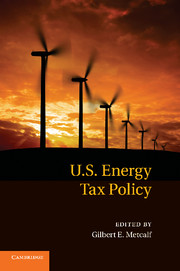Book contents
- Frontmatter
- Contents
- Conference Participants
- 1 Introduction
- 2 Distributional Impacts of Carbon Pricing Policies in the Electricity Sector
- 3 Distributional Impacts of a U.S. Greenhouse Gas Policy
- 4 Instrument Choice Is Instrument Design
- 5 Taxes, Permits, and Climate Change
- 6 Border Adjustments for Carbon Taxes and the Cost of Emissions Permits
- 7 Taxes and Caps as Climate Policy Instruments with Domestic and Imported Fuels
- 8 How Much Should Highway Fuels Be Taxed?
- 9 State Tax Policy and Oil Production
- 10 The Social Costs and Benefits of U.S. Biofuel Policies with Preexisting Distortions
- Index
- References
2 - Distributional Impacts of Carbon Pricing Policies in the Electricity Sector
Published online by Cambridge University Press: 01 June 2011
- Frontmatter
- Contents
- Conference Participants
- 1 Introduction
- 2 Distributional Impacts of Carbon Pricing Policies in the Electricity Sector
- 3 Distributional Impacts of a U.S. Greenhouse Gas Policy
- 4 Instrument Choice Is Instrument Design
- 5 Taxes, Permits, and Climate Change
- 6 Border Adjustments for Carbon Taxes and the Cost of Emissions Permits
- 7 Taxes and Caps as Climate Policy Instruments with Domestic and Imported Fuels
- 8 How Much Should Highway Fuels Be Taxed?
- 9 State Tax Policy and Oil Production
- 10 The Social Costs and Benefits of U.S. Biofuel Policies with Preexisting Distortions
- Index
- References
Summary
Introduction
It is well recognized that a carbon tax or cap-and-trade program will have its greatest impact on the electricity sector, which currently accounts for 40 percent of carbon dioxide (CO2) emissions in the United States. The sector is also a focus of concerns about the costs that climate policy will impose on households. An average household spends approximately $1,315 per year on electricity, which is 31.2 percent of total direct energy expenditures (for electricity, gasoline, natural gas, and heating oil) and 2.25 percent of average household income. In some regions of the country, these numbers are even higher, and for lower-income households the expenditures make up a considerably larger fraction of the annual income (estimates updated from Burtraw, Sweeney, and Walls [2009]).
These factors have led researchers, advocates, and policy makers to suggest a variety of approaches to reducing the impact of climate policy on consumers and alleviating regional disparities. These approaches include assorted ways of redistributing the revenue from auctioned allowances under a cap-and-trade system (or revenue from a carbon tax) and alternative means of allocating allowances under cap and trade. Most recently, H.R. 2454, the Waxman-Markey bill, has proposed that some portion of allowances under a cap-and-trade system be allocated to electricity and natural gas local distribution companies (LDCs) based on current patterns of consumption and emissions. Local distribution companies are retail providers that distribute energy to homes and businesses and are responsible for billing consumers for all the costs of delivered energy.
- Type
- Chapter
- Information
- US Energy Tax Policy , pp. 10 - 40Publisher: Cambridge University PressPrint publication year: 2010
References
- 8
- Cited by



